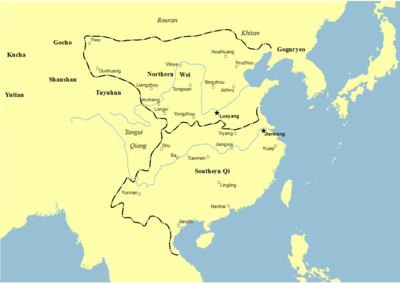Southern Qi
The Southern Qi (simplified Chinese: 南齐; traditional Chinese: 南齊; pinyin: Nán Qí) (479-502) was the second of the Southern dynasties in China, followed by the Liang Dynasty.
Qi 齊 | |||||||||
|---|---|---|---|---|---|---|---|---|---|
| 479–502 | |||||||||
 Southern Qi and neighbors | |||||||||
| Capital | Jiankang | ||||||||
| Government | Monarchy | ||||||||
| Emperor | |||||||||
• 479–482 | Emperor Gao | ||||||||
• 482–493 | Emperor Wu | ||||||||
• 501–502 | Emperor He | ||||||||
| History | |||||||||
• Established | 3 June[1] 479 | ||||||||
• Disestablished | 24 April[2] 502 | ||||||||
| Currency | Chinese coin, Chinese cash | ||||||||
| |||||||||
| Today part of | China Vietnam | ||||||||
History
The dynasty began in 479, when Xiao Daocheng forced the Emperor Shun of Liu Song into yielding the throne to him, ending Liu Song and starting Southern Qi, as its Emperor Gao.
During its 23-year history, the dynasty was largely filled with instability, as after the death of the capable Emperor Gao and Emperor Wu, Emperor Wu's grandson Xiao Zhaoye was assassinated by Emperor Wu's intelligent but cruel and suspicious cousin Xiao Luan, who took over as Emperor Ming, and proceeded to carry out massive executions of Emperor Gao's and Emperor Wu's sons and grandsons, as well as officials whom he suspected of plotting against him.[3][4]
The arbitrariness of these executions was exacerbated after Emperor Ming was succeeded by his son Xiao Baojuan, whose actions drew multiple rebellions, the last of which, by the general Xiao Yan led to Southern Qi's fall and succession by Xiao Yan's Liang Dynasty.[5]
More than fifty percent of Tuoba Xianbei princesses of the Northern Wei were married to southern Han Chinese men from the imperial families and aristocrats from southern China of the Southern dynasties who defected and moved north to join the Northern Wei.[6] Tuoba Xianbei Princess Nanyang (南阳长公主) was married to Xiao Baoyin (萧宝夤), a Han Chinese member of Southern Qi royalty.[7] Xianbei Tuoba Emperor Xiaozhuang of Northern Wei's sister the Shouyang Princess was wedded to the Han Chinese Liang dynasty ruler Emperor Wu of Liang's son Xiao Zong 蕭綜.[8]
War with Northern Wei
In 479, after Xiao Daocheng usurped the throne of Liu Song, the Northern Wei emperor prepared to invade under the pretext of installing Liu Chang, son of Emperor Wen of Liu Song who had been in exile in Wei since 465AD. Wei troops began to attack Shouyang but could not take the city. The Southern Qi began to fortify their capital, Jiankang, in order to prevent further Wei raids. Multiple sieges and skirmishes were fought until 481 but the war did not witnessed any major campaign. A peace treaty was signed in 490 with the Emperor Wu.
Sovereigns of Southern Qi Dynasty (479-502)
| Posthumous Name | Family name and given names | Period of Reigns | Era names |
|---|---|---|---|
| Emperor Gao of Southern Qi (齊高帝) | Xiao Daocheng (蕭道成) | 479-482 | Jianyuan (建元) 479-482 |
| Emperor Wu of Southern Qi (齊武帝) | Xiao Ze (蕭賾) | 482-493 | Yongming (永明) 483-493 |
| – | Xiao Zhaoye (蕭昭業) | 493-494 | Longchang (隆昌) 494 |
| – | Xiao Zhaowen (蕭昭文) | 494 | Yanxing (延興) 494 |
| Emperor Ming of Southern Qi (齊明帝) | Xiao Luan (蕭鸞) | 494-498 | Jianwu (建武) 494-498 Yongtai (永泰) 498 |
| – | Xiao Baojuan (蕭寶卷) | 499-501 | Yongyuan (永元) 499-501 |
| Emperor He of Southern Qi (齊和帝) | Xiao Baorong (蕭寶融) | 501-502[note 1] | Zhongxing (中興) 501-502 |
Sovereigns family tree
| Southern Qi | |||||||||||||||||||||||||||||||||||||||||||||||||||||||||||||||||||||||||||||||||||||||||||||||||||||||||||||||||||||||||||||||||||||||||||||||||||||||||||||||||||||||||||||||||||||||||||||||||||||||||||||||||||||||||||||||||||||||||||||||||||||||||||||||||||||||||||||||||||||||||||||||||||||||||||||||||||||||||||||||||||||||||||||||||||||||||||||||||||||||||||||||||||||||||||||||||||||||||
|---|---|---|---|---|---|---|---|---|---|---|---|---|---|---|---|---|---|---|---|---|---|---|---|---|---|---|---|---|---|---|---|---|---|---|---|---|---|---|---|---|---|---|---|---|---|---|---|---|---|---|---|---|---|---|---|---|---|---|---|---|---|---|---|---|---|---|---|---|---|---|---|---|---|---|---|---|---|---|---|---|---|---|---|---|---|---|---|---|---|---|---|---|---|---|---|---|---|---|---|---|---|---|---|---|---|---|---|---|---|---|---|---|---|---|---|---|---|---|---|---|---|---|---|---|---|---|---|---|---|---|---|---|---|---|---|---|---|---|---|---|---|---|---|---|---|---|---|---|---|---|---|---|---|---|---|---|---|---|---|---|---|---|---|---|---|---|---|---|---|---|---|---|---|---|---|---|---|---|---|---|---|---|---|---|---|---|---|---|---|---|---|---|---|---|---|---|---|---|---|---|---|---|---|---|---|---|---|---|---|---|---|---|---|---|---|---|---|---|---|---|---|---|---|---|---|---|---|---|---|---|---|---|---|---|---|---|---|---|---|---|---|---|---|---|---|---|---|---|---|---|---|---|---|---|---|---|---|---|---|---|---|---|---|---|---|---|---|---|---|---|---|---|---|---|---|---|---|---|---|---|---|---|---|---|---|---|---|---|---|---|---|---|---|---|---|---|---|---|---|---|---|---|---|---|---|---|---|---|---|---|---|---|---|---|---|---|---|---|---|---|---|---|---|---|---|---|---|---|---|---|---|---|---|---|---|---|---|---|---|---|---|---|---|---|---|---|---|---|---|---|---|---|---|---|---|---|---|---|---|---|---|---|---|---|---|---|---|---|---|---|---|---|---|---|---|---|---|---|---|---|---|---|---|---|---|---|---|---|---|---|---|---|---|
| |||||||||||||||||||||||||||||||||||||||||||||||||||||||||||||||||||||||||||||||||||||||||||||||||||||||||||||||||||||||||||||||||||||||||||||||||||||||||||||||||||||||||||||||||||||||||||||||||||||||||||||||||||||||||||||||||||||||||||||||||||||||||||||||||||||||||||||||||||||||||||||||||||||||||||||||||||||||||||||||||||||||||||||||||||||||||||||||||||||||||||||||||||||||||||||||||||||||||
Notes
- Emperor Ming's son Xiao Baoyin, who was then a Northern Wei general, rebelled against Northern Wei and claimed imperial title in 527-528, but is not listed because his claim of imperial title was temporary, long after Emperor He's reign, and also did not include any territory that was previously Southern Qi territory.
References
Citations
- Book of Southern Qi, vol. 1.
- Zizhi Tongjian, vol. 145.
- 川本『中国の歴史、中華の崩壊と拡大、魏晋南北朝』、P150
- 川本『中国の歴史、中華の崩壊と拡大、魏晋南北朝』、P152
- 川本『中国の歴史、中華の崩壊と拡大、魏晋南北朝』、P153
- Tang, Qiaomei (May 2016). Divorce and the Divorced Woman in Early Medieval China (First through Sixth Century) (PDF) (A dissertation presented by Qiaomei Tang to The Department of East Asian Languages and Civilizations in partial fulfillment of the requirements for the degree of Doctor of Philosophy in the subject of East Asian Languages and Civilizations). Cambridge, Massachusetts: Harvard University. pp. 151, 152, 153.
- China: Dawn of a Golden Age, 200-750 AD. Metropolitan Museum of Art. 2004. pp. 30–. ISBN 978-1-58839-126-1.
Xiao Baoyin.
- Ancient and Early Medieval Chinese Literature (vol.3 & 4): A Reference Guide, Part Three & Four. BRILL. 22 September 2014. pp. 1566–. ISBN 978-90-04-27185-2.
Sources
- Book of Southern Qi
- History of Southern Dynasties
- Zizhi Tongjian
See also
- Southern and Northern Dynasty
- Chinese sovereign
- Yongming poetry
- List of Bronze Age States
- List of Classical Age States
- List of Iron Age States
- List of pre-modern great powers